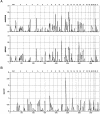A genomewide scan for loci involved in attention-deficit/hyperactivity disorder
- PMID: 11923911
- PMCID: PMC447594
- DOI: 10.1086/340112
A genomewide scan for loci involved in attention-deficit/hyperactivity disorder
Abstract
Attention deficit/hyperactivity disorder (ADHD) is a common heritable disorder with a childhood onset. Molecular genetic studies of ADHD have previously focused on examining the roles of specific candidate genes, primarily those involved in dopaminergic pathways. We have performed the first systematic genomewide linkage scan for loci influencing ADHD in 126 affected sib pairs, using a approximately 10-cM grid of microsatellite markers. Allele-sharing linkage methods enabled us to exclude any loci with a lambda(s) of > or =3 from 96% of the genome and those with a lambda(s) of > or =2.5 from 91%, indicating that there is unlikely to be a major gene involved in ADHD susceptibility in our sample. Under a strict diagnostic scheme we could exclude all screened regions of the X chromosome for a locus-specific lambda(s) of >/=2 in brother-brother pairs, demonstrating that the excess of affected males with ADHD is probably not attributable to a major X-linked effect. Qualitative trait maximum LOD score analyses pointed to a number of chromosomal sites that may contain genetic risk factors of moderate effect. None exceeded genomewide significance thresholds, but LOD scores were >1.5 for regions on 5p12, 10q26, 12q23, and 16p13. Quantitative-trait analysis of ADHD symptom counts implicated a region on 12p13 (maximum LOD 2.6) that also yielded a LOD >1 when qualitative methods were used. A survey of regions containing 36 genes that have been proposed as candidates for ADHD indicated that 29 of these genes, including DRD4 and DAT1, could be excluded for a lambda(s) of 2. Only three of the candidates-DRD5, 5HTT, and CALCYON-coincided with sites of positive linkage identified by our screen. Two of the regions highlighted in the present study, 2q24 and 16p13, coincided with the top linkage peaks reported by a recent genome-scan study of autistic sib pairs.
Figures


References
Electronic-Database Information
-
- Cooperative Human Linkage Centre, http://lpg.nci.nih.gov/ABI/index.html
-
- Genehunter, http://www.fhcrc.org/labs/kruglyak/Downloads/
-
- Mapmaker/SIBS, http://www-genome.wi.mit.edu/ftp/distribution/software/sibs/
-
- Online Mendelian Inheritance in Man (OMIM), http://www.ncbi.nlm.nih.gov/Omim/ (for ADHD [MIM 143465]) - PubMed
References
-
- Achenbach TM (1993) Empirically based taxonomy: how to use syndromes and profile types derived from the CBCL from 4 to 18, TRF, and WSR. University of Vermont Department of Psychiatry, Burlington, VA
-
- American Psychiatric Association (1994) Diagnostic and statistical manual of mental disorders, 4th edition (DSM-IV). American Psychiatric Association, Washington DC
-
- Barr CL, Xu C, Kroft J, Feng Y, Wigg K, Zai G, Tannock R, Schachar R, Malone M, Roberts W, Nothen MM, Grunhage F, Vandenbergh DJ, Uhl G, Sunohara G, King N, Kennedy JL (2001) Haplotype study of three polymorphisms at the dopamine transporter locus confirm linkage to attention-deficit/hyperactivity disorder. Biol Psychiatry 49:333–339 - PubMed
-
- Biederman J, Faraone SV, Keenan K, Benjamin J, Krifcher B, Moore C, Sprich-Buckminster S, Ugaglia K, Jellinek MS, Steingard R (1992) Further evidence for family-genetic risk factors in attention deficit hyperactivity disorder. Patterns of comorbidity in probands and relatives psychiatrically and pediatrically referred samples. Arch Gen Psychiatry 49:728–738 - PubMed
Publication types
MeSH terms
Associated data
- Actions
Grants and funding
LinkOut - more resources
Full Text Sources
Other Literature Sources
Medical

